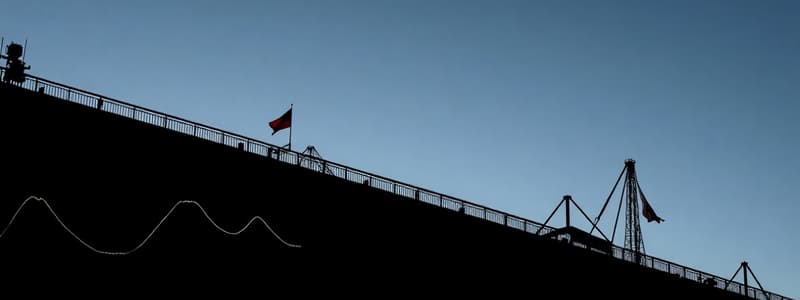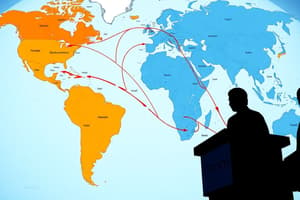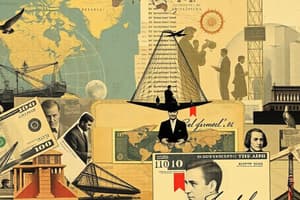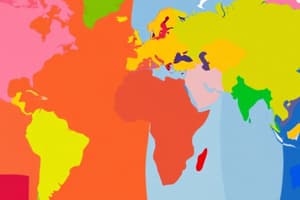Podcast
Questions and Answers
Which historical trade route, introduced by China, facilitated the global transportation of goods across the Eurasian landmass?
Which historical trade route, introduced by China, facilitated the global transportation of goods across the Eurasian landmass?
- The Spice Route
- The Silk Road (correct)
- The Incense Route
- The Tea Horse Road
What was the primary objective of establishing the Bretton Woods System after World War II?
What was the primary objective of establishing the Bretton Woods System after World War II?
- To establish a gold standard for international currencies
- To promote isolationist economic policies among nations
- To create a system of fixed exchange rates based on the British pound
- To prevent another Great Depression through international economic cooperation (correct)
Which organization replaced the General Agreement on Tariffs and Trade (GATT) and broadened the scope of trade liberalization efforts?
Which organization replaced the General Agreement on Tariffs and Trade (GATT) and broadened the scope of trade liberalization efforts?
- World Bank
- World Trade Organization (WTO) (correct)
- United Nations Conference on Trade and Development (UNCTAD)
- International Monetary Fund (IMF)
According to Hamilton (2008), what is economic globalization primarily characterized by?
According to Hamilton (2008), what is economic globalization primarily characterized by?
Which of the following best describes the impact of trade on international relations and societies?
Which of the following best describes the impact of trade on international relations and societies?
What does the decentralization of production in the global economy entail?
What does the decentralization of production in the global economy entail?
What is the role of 'global value chains' in global trade networks?
What is the role of 'global value chains' in global trade networks?
What is the primary factor driving the skyrocketing demand for commodities in the global market?
What is the primary factor driving the skyrocketing demand for commodities in the global market?
Which scenario exemplifies the 'race to the bottom' competition in the global economy?
Which scenario exemplifies the 'race to the bottom' competition in the global economy?
What is the concept of 'industrial upgrading' in the context of global trade?
What is the concept of 'industrial upgrading' in the context of global trade?
What is the defining characteristic of Intergovernmental Organizations (IGOs)?
What is the defining characteristic of Intergovernmental Organizations (IGOs)?
Which of the following is an example of a Supranational Organization?
Which of the following is an example of a Supranational Organization?
Which category of Non-Governmental Organizations (NGOs) is primarily focused on influencing governments on specific issues?
Which category of Non-Governmental Organizations (NGOs) is primarily focused on influencing governments on specific issues?
Which activity is commonly associated with Multinational Corporations (MNCs) and Transnational Corporations (TNCs)?
Which activity is commonly associated with Multinational Corporations (MNCs) and Transnational Corporations (TNCs)?
What characterizes 'Market Integration'?
What characterizes 'Market Integration'?
Which of the following is an effect of market development through market integration?
Which of the following is an effect of market development through market integration?
What is the primary function of the International Monetary Fund (IMF)?
What is the primary function of the International Monetary Fund (IMF)?
What is the primary objective of Trade-Related Aspects of Intellectual Property Rights (TRIPS)?
What is the primary objective of Trade-Related Aspects of Intellectual Property Rights (TRIPS)?
Which of the following is an example of Trade-Related Investment Measures (TRIMS)?
Which of the following is an example of Trade-Related Investment Measures (TRIMS)?
Which factor is considered a part of Global Economic Integration?
Which factor is considered a part of Global Economic Integration?
What is Foreign Direct Investment (FDI)?
What is Foreign Direct Investment (FDI)?
Which of the following describes Regional Integration?
Which of the following describes Regional Integration?
Which attribute is characteristic of Global Corporations?
Which attribute is characteristic of Global Corporations?
What is a potential disadvantage of Global Corporations?
What is a potential disadvantage of Global Corporations?
To what does the modern nation-state trace its origins?
To what does the modern nation-state trace its origins?
What is the principle of sovereignty, as established by the Treaty of Westphalia?
What is the principle of sovereignty, as established by the Treaty of Westphalia?
How has globalization affected the nation-state?
How has globalization affected the nation-state?
What is the 'Imagined Community' concept, as described by Benedict Anderson?
What is the 'Imagined Community' concept, as described by Benedict Anderson?
Which of the following is a key component of a 'state'?
Which of the following is a key component of a 'state'?
What does the interstate system primarily involve?
What does the interstate system primarily involve?
What does the principle of nationalism primarily promote?
What does the principle of nationalism primarily promote?
Which of the following describes political globalization?
Which of the following describes political globalization?
What is the role of International Organizations (IGOs)?
What is the role of International Organizations (IGOs)?
As globalization grows, what is happening to the power of the nation-state?
As globalization grows, what is happening to the power of the nation-state?
According to Karns and Mingst, what is Global Governance?
According to Karns and Mingst, what is Global Governance?
What is a major role of the United Nations (UN)?
What is a major role of the United Nations (UN)?
Which of the following is identified as a 'gap' in global governance?
Which of the following is identified as a 'gap' in global governance?
Which issue is considered a major global issue?
Which issue is considered a major global issue?
In the context of global governance, what is a crucial future need?
In the context of global governance, what is a crucial future need?
How did the Bretton Woods System (1944-1971) impact the international monetary landscape?
How did the Bretton Woods System (1944-1971) impact the international monetary landscape?
In what way does the global economy alter the dynamics of production and control within urban centers?
In what way does the global economy alter the dynamics of production and control within urban centers?
What is the role of 'global value chains' in the context of international commerce?
What is the role of 'global value chains' in the context of international commerce?
How have countries like China and Mexico transitioned within the global market regarding production value?
How have countries like China and Mexico transitioned within the global market regarding production value?
How does the principle of sovereignty relate to the structure and function of Intergovernmental Organizations (IGOs)?
How does the principle of sovereignty relate to the structure and function of Intergovernmental Organizations (IGOs)?
Flashcards
What is an Economy?
What is an Economy?
The basic foundation that influences the condition of society and politics.
Worldwide Economic Status
Worldwide Economic Status
A country's economic standing in the world, showing its ability to compete.
Historical Economic Relationships
Historical Economic Relationships
Economic relationships established in the past, showing historical trade connections.
Bretton Woods System (1944-1971)
Bretton Woods System (1944-1971)
Signup and view all the flashcards
The US dollar
The US dollar
Signup and view all the flashcards
General Agreement on Tariffs and Trade (GATT)
General Agreement on Tariffs and Trade (GATT)
Signup and view all the flashcards
World Trade Organization (WTO)
World Trade Organization (WTO)
Signup and view all the flashcards
International Monetary Fund (IMF)
International Monetary Fund (IMF)
Signup and view all the flashcards
Economic Globalization
Economic Globalization
Signup and view all the flashcards
Trade
Trade
Signup and view all the flashcards
Global Economy
Global Economy
Signup and view all the flashcards
Global Trade Networks
Global Trade Networks
Signup and view all the flashcards
Global Value Chains
Global Value Chains
Signup and view all the flashcards
Demand for Commodities
Demand for Commodities
Signup and view all the flashcards
Oil
Oil
Signup and view all the flashcards
"Race to the Bottom"
"Race to the Bottom"
Signup and view all the flashcards
Industrial Upgrading
Industrial Upgrading
Signup and view all the flashcards
Intergovernmental Organizations (IGOs)
Intergovernmental Organizations (IGOs)
Signup and view all the flashcards
Supranational Organizations
Supranational Organizations
Signup and view all the flashcards
Non-Governmental Organizations (NGOs)
Non-Governmental Organizations (NGOs)
Signup and view all the flashcards
Advocacy NGOs
Advocacy NGOs
Signup and view all the flashcards
Operational NGOs
Operational NGOs
Signup and view all the flashcards
Multinational Corporations (MNCs)
Multinational Corporations (MNCs)
Signup and view all the flashcards
Transnational Corporations (TNCs)
Transnational Corporations (TNCs)
Signup and view all the flashcards
Market Integration
Market Integration
Signup and view all the flashcards
International Monetary Fund (IMF)
International Monetary Fund (IMF)
Signup and view all the flashcards
World Bank
World Bank
Signup and view all the flashcards
World Trade Organization (WTO)
World Trade Organization (WTO)
Signup and view all the flashcards
TRIPS
TRIPS
Signup and view all the flashcards
TRIMS
TRIMS
Signup and view all the flashcards
Privatization
Privatization
Signup and view all the flashcards
Deregulation
Deregulation
Signup and view all the flashcards
Foreign Direct Investment (FDI)
Foreign Direct Investment (FDI)
Signup and view all the flashcards
Trade Liberalization
Trade Liberalization
Signup and view all the flashcards
Regional Integration
Regional Integration
Signup and view all the flashcards
Global Corporation Attributes
Global Corporation Attributes
Signup and view all the flashcards
Nationalism
Nationalism
Signup and view all the flashcards
Internationalism
Internationalism
Signup and view all the flashcards
Political Globalization
Political Globalization
Signup and view all the flashcards
International Organizations (IGOs)
International Organizations (IGOs)
Signup and view all the flashcards
Decline of the Nation-State
Decline of the Nation-State
Signup and view all the flashcards
Global Governance
Global Governance
Signup and view all the flashcards
United Nations (UN)
United Nations (UN)
Signup and view all the flashcards
Knowledge Gap
Knowledge Gap
Signup and view all the flashcards
Study Notes
The Global Economy
- Economy is the basis of society, influencing its condition and politics
- A country's economic status reflects its economic mobility, crucial for global competition
- Historically, economic relationships include the Philippines bartering with China for porcelains and silk
- Spain implemented the Galleon Trade in the Philippines
- China introduced the Silk Road as the central Eurasian trade route
Bretton Woods System (1944-1971)
- It was created post-World War II to avert another Great Depression
- Established international cooperation and facilitated free capital flow globally
- The US dollar became the standard global currency for stable exchange rates
- This system led to global structures, including the General Agreement on Tariffs and Trade (GATT)
- GATT sought to lower trade barriers
- The World Trade Organization (WTO) then replaced GATT
- The WTO focused on reducing non-tariff barriers and ensuring free trade
- The International Monetary Fund (IMF) was also founded
- The IMF stabilizes global monetary systems
Economic Globalization & Trade
- Economic globalization involves trading and investing between countries
- Trade is a driving force in international relations, affecting nearly every aspect of society
- The global economy decentralizes production while centralizing command and control in global cities
- Global trade uses networks, including supply chains and international production networks
- Global trade also occurs through global commodity chains
- As well as global value chains that track value creation through various stages
Global Commodity Demand & Economic Disparity
- Demand for commodities is rapidly increasing, especially in developing countries like China
- Scarcity, exemplified by oil, leads to increased prices and geopolitical tensions
- Some countries lower prices and wages to attract investment, causing a "race to the bottom"
- Some countries like China and Mexico initially used low-cost production
- Followed by a shift to higher-value production at higher wages, known as "industrial upgrading"
Actors in Globalization: Categories of Organizations
- Intergovernmental Organizations (IGOs) primarily consist of sovereign states which have international personality due to treaties
- World Trade Organization (WTO)
- World Health Organization (WHO)
- Asian Development Bank (ADB)
- Supranational Organizations promote economic, political, or cultural unity beyond multiple states' borders
- United Nations (UN)
- International Labor Organization (ILO)
- European Union (EU)
- Non-Governmental Organizations (NGOs) operate independently of governments
- Advocacy NGOs influence governments on specific issues
- Operational NGOs provide services
- Amnesty International
- International Red Cross
- International Chamber of Commerce
- Multinational Corporations (MNCs) operate and control goods/services production in multiple countries
- Transnational Corporations (TNCs) maintain facilities with business in multiple countries
- Common activities include importing/exporting, investing, licensing, contract manufacturing, and opening manufacturing/assembly operations abroad
Market Integration
- Market integration occurs when related markets show similar price trends, intentionally or unintentionally
- Market Development expands market coverage
- Also, reduces failures, and equalizes prices
International Financial Institutions
- The International Monetary Fund (IMF) ensures monetary stability and manages exchange rates
- World Bank provides funds for government-sponsored projects
- The World Trade Organization (WTO) facilitates trade agreements
- Also, it oversees trade-related intellectual property and investment measures
TRIPS & TRIMS in Global Trade
- Trade-Related Aspects of Intellectual Property Rights (TRIPS) is a WTO agreement protecting intellectual property
- It also ensures intangible ideas are protected worldwide
- Trade-Related Investment Measures (TRIMS) are rules preventing unfair trade practices for foreign businesses
- They ensure foreign investments do not distort trade and require local materials
Global Economic Integration Factors
- Privatization involves transferring state-owned businesses
- Deregulation removes government restrictions
- Foreign Direct Investment (FDI) is investment by a foreign company
- Trade Liberalization lowers trade barriers
Attributes of Global Corporations
- They operate globally with huge assets and centralized management
- They also have influence, use technology, and employ top executives
Advantages & Disadvantages of Global Corporations
- Advantages include foreign capital investment, job creation, and technological advancement
- Advantages include increased exports and healthy competition
- Disadvantages include exploitation, adverse effects on local businesses, and cultural homogenization
- Disadvantages include influence on government policies and environmental concerns
Key Takeaways
- The global economy is shaped by trade systems, post-WWII frameworks, and financial institutions
- Organizations and corporations drive globalization
- Market integration influences price stability, trade liberalization, and investment flows
- Global corporations have both positive and negative impacts locally and globally
The Global Interstate System
- The modern nation-state traces back to the Treaty of Westphalia (1648)
- This treaty established autonomous nation-states with control over domestic affairs
- Globalization has challenged the nation-state, leading to loss of control
- The nation-state remains an important political structure despite declining power
Key Concepts
- Nation-state porosity increases with globalization
- Meaning that borders open to trade, migration, and information
- Benedict Anderson's "Imagined Community" involves nations constructed through print capitalism
- People identify with shared culture
- Nation-states transcend adapting to changing technology and immigration
The Nation-State
- The nation-state has state and nation concepts
- A state is a country with territory, sovereignty, and government
- A nation, defined as an "imagined community," shares boundaries and a common language, traditions, and ethnicity
The Interstate System
- The interstate system consists of competing and allying states shaped by the Treaty of Westphalia (1648)
- The Treaty of Westphalia concluded the Thirty Years' War
- It established sovereignty by not permitting countries to interfere with each other's affairs
Principles of the Interstate System
- Nationalism promotes national unity and interests
- Internationalism involves greater cooperation through various partnerships
Effects of Globalization on Governments
- Political globalization involves international organizations
- United Nations (UN)
- Non-Governmental Organizations (NGOs)
- These organizations help manage:
- Relief efforts
- Environmental protection
- As well as immigration
- International Organizations (IGOs) are created by nation-states
- IGOs operate on intergovernmental principles with unanimous consent
- IGOs include the European Union (EU) and the World Trade Organization (WTO)
The Decline of the Nation-State
- The power of the nation-state decreases while globalization increases
- Sovereign states privatize responsibilities and lose influence to TNCs and NGOs
- International organizations (IGOs) are growing stronger
Contemporary Global Governance
- Governance establishes policies and monitoring implementation
- Global governance involves activities that deals with:
- Armed conflicts
- Technology risks
- Economic stability
- Climate change
Functions of the United Nations (UN)
- The UN promotes international peace and order as an intergovernmental organization
- Replaced the League of Nations
- Founded on October 24, 1945
Goals of the UN
- It is designed to maintain international peace and security
- It also fosters relations between countries
- The UN is intended to assist countries in solving problems and promoting rights worldwide
Main Organs of the UN
- General Assembly – Main decision-making body
- Security Council – Maintains international peace and security
- Secretariat – Administrative body led by the Secretary-General
- Trusteeship Council – Oversaw trust territories
- Economic and Social Council (ECOSOC) – Handles development and human rights
- International Court of Justice – Resolves legal disputes between countries
Achievements of the UN
- The UN has helped countries become peaceful
- The UN has addressed environmental issues (Earth Summit 1992)
- IAEA (International Atomic Energy Agency) monitors weapons
- The UN has fights with poverty, trafficking, and hunger
Challenges of Global Governance
- Weis (2015) identified knowledge
- Weis (2015) identified normative
- Weis (2015) identified policy
- Weis (2015) identified institutional
- Weis (2015) identified compliance gap as challenges
Major Global Issues
- Global issues that require addressing include:
- Terrorism
- Nuclear proliferation
- Humanitarian crises
- Climate change
- Human rights violations
- Global pandemics
Future of Global Governance
- Future governance requires:
- Reforming global institutions
- Stronger enforcement
- Ensuring benefits reach all
Key Takeaways
- The nation-state system is now challenged by globalization
- IGOs and NGOs are taking on responsibilities held by nation-states
- The UN governance faces challenges in policy
- Global governance must evolve to address modern issues, terrorism, and change
Studying That Suits You
Use AI to generate personalized quizzes and flashcards to suit your learning preferences.




